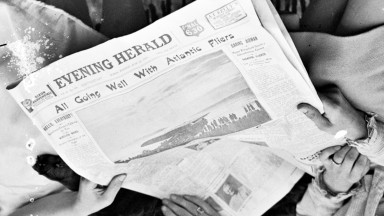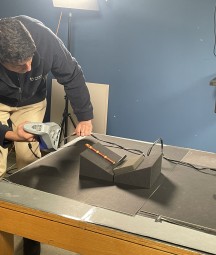Some people might be able to cite the day that Amelia Earhart landed in a field in Derry in 1932, making her the first to complete a solo transatlantic flight. The National Library of Ireland (NLI) has a selection of photographs documenting that event, which happened on May 21, 1932. One of the photographs is reproduced in our exhibition People and Places at the National Photographic Archive in Meeting House Square, Temple Bar.
Earhart made history when she landed in Derry, joining a long line of notable aviators in Ireland. From radio operators and navigators to pioneering female pilots, there is plenty of Irish aviation history to explore!
Marking the Bray Air Display weekend (which takes place this year on August 3, 2024), an event that brings together aviation fans and casual spectators alike, we invite you to learn more about this unique part of Irish history.
Looking at the National Library’s vast collection of newspapers you can find information on Lady Mary Heath (1896-1939). Although she became well known by that name, she was born Sophie Catherine Theresa Peirce-Evans in Knockaderry, in County Limerick. Always athletic, she turned her interests to aviation around 1925. She was the first female member of the London Light Aeroplane Club, and she had qualified for her private licence by November 1925.
At the time, the International Commission for Air Navigation had banned commercial licenses for women. Heath pressured them to let her apply. When they said she could test for the license, it was under the stipulation that she complete the fitness portion while menstruating. In January 1926, she became Britain’s first recognised female commercial pilot. Heath was often in the public eye. She made a career racing, teaching and performing stunts. As shown in this piece from the Evening Herald on July 11, 1928.
Copies of the Evening Herald from December 19, 1891, through March 9, 2013, are available in the NLI’s Microfilm Reading Room. You can also peruse them digitally onsite through our subscription to the Irish Newspaper Archives.
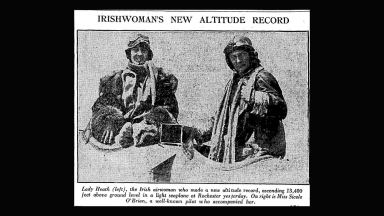
Evening Herald; 11 July 1928– page 1
Earlier that year, Lady Mary Heath had become the first person to fly solo from Cape Town, South Africa to London. She took off in January and made the final touchdown in May of 1928, flying in her Avro Avian, which was an open cockpit biplane model.
After completing the journey to London, Lady Heath gave a quote to the Daily Express saying:
“It is so safe that a woman can fly across Africa wearing a Parisian frock and keeping her nose powdered all the way.”
While Lady Heath herself made light of her accomplishments for the paper, she was a very accomplished flier, and the journey was far from easy. She suffered from sunstroke in Zimbabwe, which forced her to make an emergency landing.
Later that same year, Earhart met Heath when she was in London. Heath extended an invitation for a flight in her Avro Avian. Earhart, who was apparently enamoured with the plane, accepted an offer to buy it off Heath and had it shipped back to America.
Lady Heath once said:
“Ireland is an ideal country for flying. It is much better than England because the country is so much more pastoral and there are larger fields.”
This observation would later prove to be true for Earhart when she unexpectedly finished her own record setting solo flight in Derry, four years after Heath’s major flight.
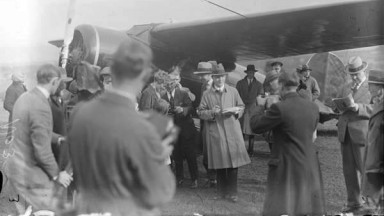
Miss Amelia Earhart, Atlantic Flier at Derry beside Aircraft, Independent Newspapers Collection (IND H 2475)
Heath and Earhart were not the only ones convinced of Ireland’s suitability for flying. The NLI has other photographs that document other significant aviation events that took place in Ireland. In 1928, the Australian pilot Charles Kingsford Smith embarked upon his circumnavigation of the world. In 1930, he arrived in Ireland—just a few flights away from North America and Oakland, California, where he would complete his loop. Smith landed in and took off from Portmarnock—where this historic event is still celebrated today.
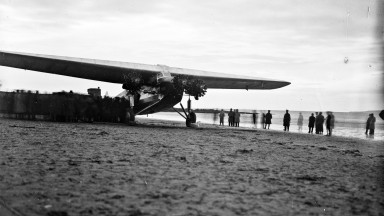
Southern Cross, Atlantic Flight: crowds surround aircraft, 1930, Independent Newspapers Collection (IND H 1494)
Four men took off from Portmarnock Strand at 12:57 on June 24 in the Southern Cross plane, including Paddy Saul, the navigator who was from Skerries.
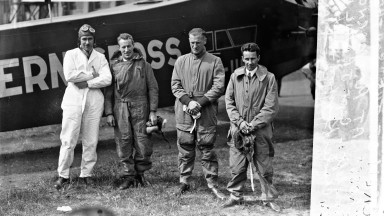
Transatlantic Flights: Crew of the "Southern Cross" at Portmarnock. L-R: Captain JP Saul, Navigator, Sir Charles Kingsford-Smith, Skipper, JW Stannage and Van Dyck, Independent Newspapers Collection (IND H 2842)
The team sent frequent radio message back to operators and the public. Here two women operate radio equipment to listen in for the updates. This image is from the vast Independent Newspapers Collection, which now forms part of the five million photographs in the NLI's collection.
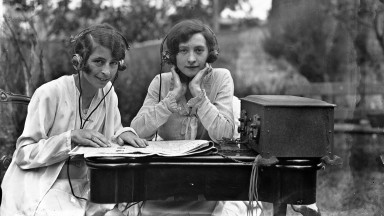
Southern Cross, Atlantic Flight: Two women operating radio equipment, 1930, Independent Newspapers Collection (IND H 1511)
The newspaper reported events as they happened across the duration of the flight, which took around 31 hours. This newspaper is being held by the two women, and is a detail taken from another image on the same day.
All modern aviation achievements are underpinned by the daring aviators who went before them, and you can read more about their adventures in in the NLI's iconic Reading Rooms. This is just a small piece on what is a vast archive of material at the National Library. If you are going to watch the display this weekend at Bray, you are following in the footsteps of Lord Carberry, who, on July 18, 1914, took off from Woodbrook Estate near Bray in his Morane-Saulnier H airplane. He then put on a display of aviation stunts while a crowd watched from Bray Harbour wall—gathering the same way as many will do this weekend.
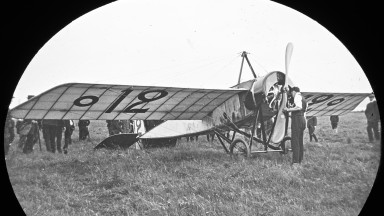
Lord Carbery's Morane at Bray, photographed by Thomas Holmes Mason, 18 July 1914, Mason Photographic Collection (M24/60/9)
Learn more:
Visit our exhibition People and Places at the National Photographic Archive to see Earhart’s famous landing and explore our catalogue for more material on early aviation.
A reader’s ticket is required to access all reading rooms and research spaces. You may apply for your free reader’s ticket by using our online application form.
You can explore the following sources from Irish authors:
- Naughton, Lindie. Lady Icarus: the Life of Irish Aviator Lady Mary Heath. Dublin: Ashfield Press, 2004
- Traynor, Michael. Petticoat Pilots. Dublin: Michael Traynor, 2019
Our readings rooms and research spaces are open Monday, Thursday & Friday: 9.30am - 5pm; Tuesday - Wednesday: 9.30am - 7pm; and select Saturdays. Find out more here.
Delve deeper to discover more about our photographic collection by looking at the NLI's Flicker. In 2011, NLI started sharing images from our collections with no known copyright restrictions with the general public. Together with more than a hundred other national libraries, archives, and museums, we continue to share our photographic collections with a far-reaching online audience through the Flickr Commons. Flickr users give freely and generously of their time to help us to identify key information about them.
Additional Sources:
- Amelia Earhart in the Avro-Avian Biplane Received from Lady Heath, 1928 (84.1.1629.33) From the Collections of The Henry Ford
- Amelia Earhart, The National Air and Space Museum – The Smithsonian
- Mary Heath – Dictionary of Irish Biography
-----------
By Anna Pitts
Education Assistant

